Revising sex and gender in the TEI Guidelines
| @epyllia GitHub: ebeshero |
@raffazizzi GitHub: raffazizzi |
GitHub: HelenaSabel |
@JanelleJenstad GitHub: JanelleJenstad |
|---|
TEI Conference 2022 @ Newcastle University
Session 1B. ARMB: 2.16
Wed. 14 September 2022 @ 9:30am
Link to this deck:
TEI’s troubled past
- Representation of sex / lack of gender
- Confusion with physical states/traits
- Language of Names/Dates chapter and related elements + attributes
Where TEI started from: ISO/IEC 5218
- 0 = Not known;
- 1 = Male;
- 2 = Female;
- 9 = Not applicable.
Signs of discontent in Council ~2010
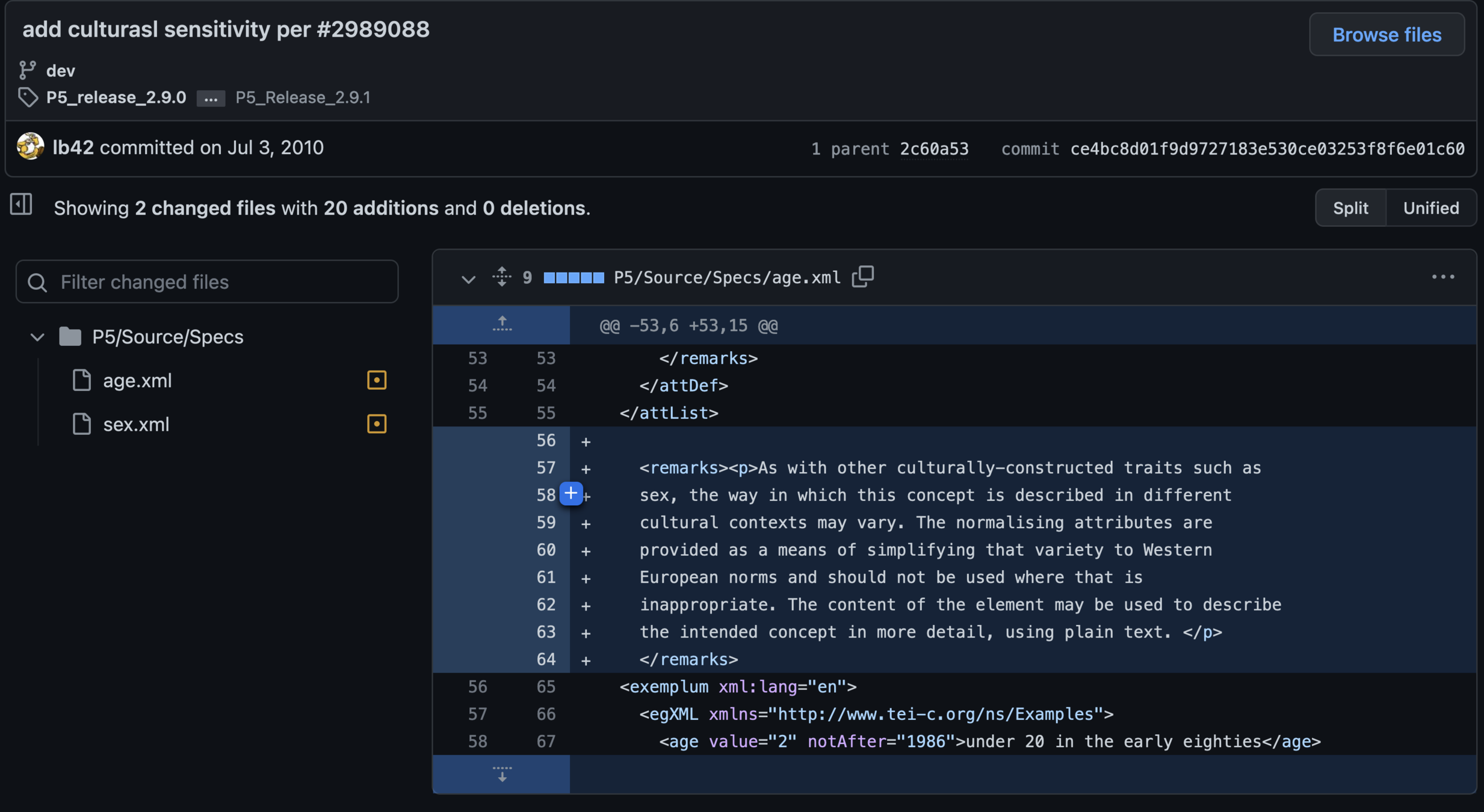
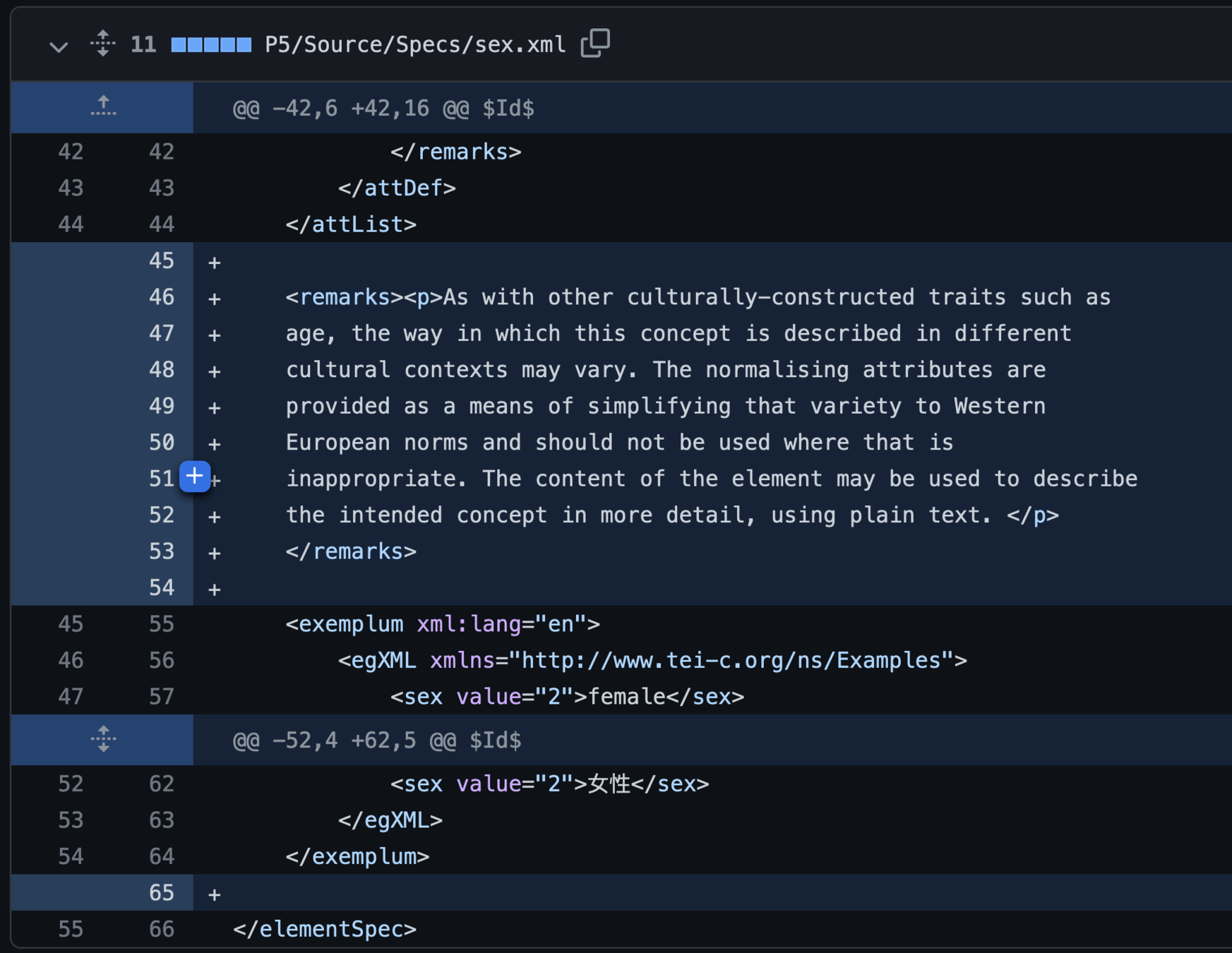
Melissa Terras’s ticket
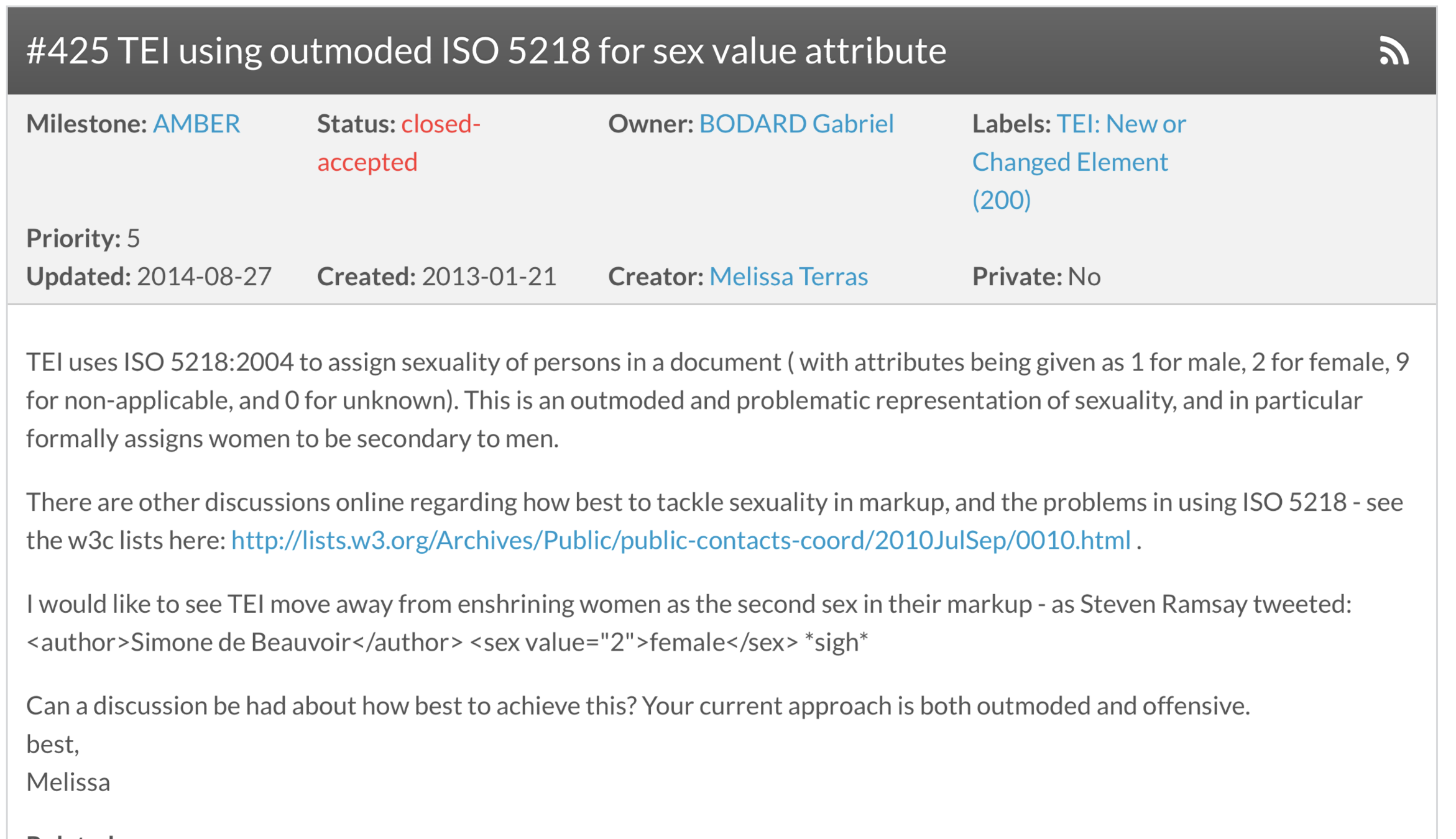
Sourceforge ticket 2013 (GitHub ticket #426)
2013 TEI Council
via Gabriel Bodard
- changes the datatypes on data.sex.xml (now teidata.sex.xml)
- from ISO numbers to data.word (now teidata.word)
- used in the @sex attribute value and the @value on <sex>
- introduces language that indicates ISO is "widely considered inadequate"
- introduces the vCard standard as an alternative to ISO
April 2013
via Gabriel Bodard
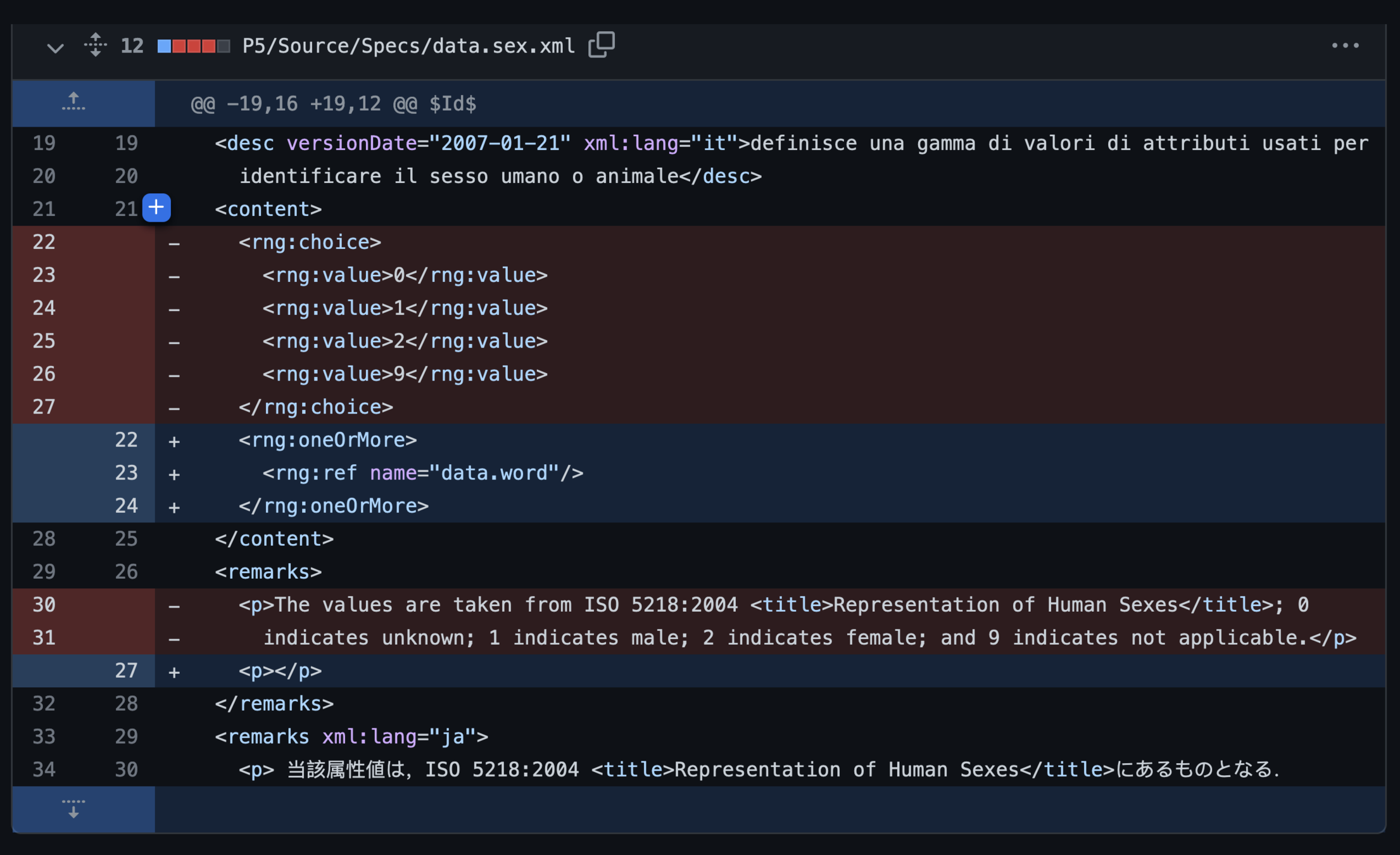

April 2013
via Gabriel Bodard
April 2013: vCard
2021 - 2022 Council
proposal for <persPronoun> from Ash Clark (2020)
via Meaghan Brown, with Syd Bauman
- Introduction of persPronoun for personographies (2021/22)
-
New example for the Names/Dates chapter (recently modified)

Persistent problems/calls for revision
- Assumptions in the language about gender / sex in the Guidelines
-
Calls in the community for something more than an encoding of linguistic morphological gender
-
connected with personography and prosopography structures in the Guidelines.
-
<persona> available since 2016 as distinct from person.
-
TEI projects are better able to describe invented, performed identities.
-
-
Review state vs. trait encoding and discussion in ND
-
Theory and practice:
our revision process
Is TEI theoretical?
- We create document data models
- Our encoding decisions express a theory of text
-
Can TEI theorize about how texts respond to culture?
- about sex and gender
- class and ethnic divisions
- about nature and classification of life
-
Can TEI theorize about how texts respond to culture?
- The mundane work of prosopography can advance a theory of past lives
- e.g. Digital Dinah Craik
- e.g. Henry III Fine Roles (Taxation documents)
- e.g. Carl Maria von Weber Gesamtausgabe
- ...
TEI without reductiveness?
- Computational culture has a problem with racism and sexism (let us count the ways)
- machine learning/AI
- "global north" economy / assumptions about who uses computers
- emphasis on the "now" and lack of awareness of other times/places/ways
- Standard forms that collect data about people: also reductive
- Can TEI intervene?
- As humanities scholarship: applying pressure against reductive paradigms
- As alternative modeling; systematically investigating structures and forms of other times and places
sex/gender systems
”Every society also has a sex/gender system—a set of arrangements by which the biological raw material of human sex and procreation is shaped by human, social intervention and satisfied in a conventional manner, no matter how bizarre some of the conventions may be.”
Source: Gayle Rubin, "The Traffic in Women: Notes on the 'Political Economy' of Sex," Toward an Anthropology of Women, ed. Rayna Reiter (New York: Monthly Review Press, 1975) 165.
- How we started talking about Gayle Rubin...
- a theoretical model based on diverse world cultures
- pulls sex and gender together in a cultural matrix
- helps us think about our -ography codification: representative of a cultural system with its own particular rules
Revision work of 2022
how we introduced gender
discussion of traits

<note place="bottom">For example, see Renato G. Mazzolini's historical survey
of European empires and their unstable constructions of race.<ptr target="#mazz-NDPERSbp"/></note>
| ”Colonialism and the Emergence of Racial Theories” in Reproduction: Antiquity to the Present Day, ed. Fleming and Kassell (Cambridge U. Press, 2018). |

discussion of traits
changes in state

changes in state

documentation and guidance

documentation and guidance

removing standards

removing standards

introducing <gender> and teidata.gender
and
revising <sex> and teidata.sex
<gender>
| <gender> | (gender) specifies the gender identity of a person, persona, or character. [13.3.2.1 Personal Characteristics] |
| Module | namesdates — Names, Dates, People, and Places |
| Attributes | att.global (@xml:id, @n, @xml:lang, @xml:base, @xml:space) (att.global.rendition (@rend, @style, @rendition)) (att.global.linking (@corresp, @synch, @sameAs, @copyOf, @next, @prev, @exclude, @select)) (att.global.analytic (@ana)) (att.global.facs (@facs)) (att.global.change (@change)) (att.global.responsibility (@cert, @resp)) (att.global.source (@source)) att.editLike (@evidence, @instant) att.datable (@calendar, @period) (att.datable.w3c (@when, @notBefore, @notAfter, @from, @to)) (att.datable.iso (@when-iso, @notBefore-iso, @notAfter-iso, @from-iso, @to-iso)) (att.datable.custom (@when-custom, @notBefore-custom, @notAfter-custom, @from-custom, @to-custom, @datingPoint, @datingMethod)) att.typed (type, @subtype) |
<gender>
| Attributes | @value | supplies a coded value for gender identity | |
| Status | Optional | ||
| Datatype | 1–∞ occurrences of teidata.gender separated by whitespace | ||
| Note | Values for this attribute may be locally defined by a project, or they may refer to an external standard. | ||
<gender>
| Member of | model.persStateLike |
| Contained by | namesdates: person personGrp persona |
| Note | As with other culturally-constructed traits such as age and sex, the way in which this concept is described in different cultural contexts varies. The normalizing attributes are provided only as an optional means of simplifying that variety for purposes of interoperability or project-internal taxonomies for consistency, and should not be used where that is inappropriate or unhelpful. The content of the element may be used to describe the intended concept in more detail. |
| Example | <gender value="NB">non-binary</gender> |
teidata.gender
| teidata.gender | defines the range of attribute values used to represent the gender of a person, persona, or character. |
| Module | tei — The TEI Infrastructure |
| Used by | gender/@value person/@gender persona/@gender |
| Content model | <content> <dataRef key="teidata.enumerated"/> </content> |
| Note | Values for attributes using this datatype may be defined locally by a project, or they may refer to an external standard. Values for this datatype should not be used to encode morphological gender (cf. gen, msd as defined in att.linguistic, and 9.3.1 Information on Written and Spoken Forms). |
<sex>
| <sex> |
(sex) specifies the sex of |
||
| Attributes | |||
implicit |
|||
- generalized the reference from people to life-forms
- removed the suggested values for @type
- got us thinking about maybe an <organism> element...
<sex>
| Note (concerning the description of @value) | Values for this attribute may be locally defined by a project, or may refer to an external standard |
What's next?
Customize your own ontology!
#2341: Council now calls for <entity> and <listEntity>
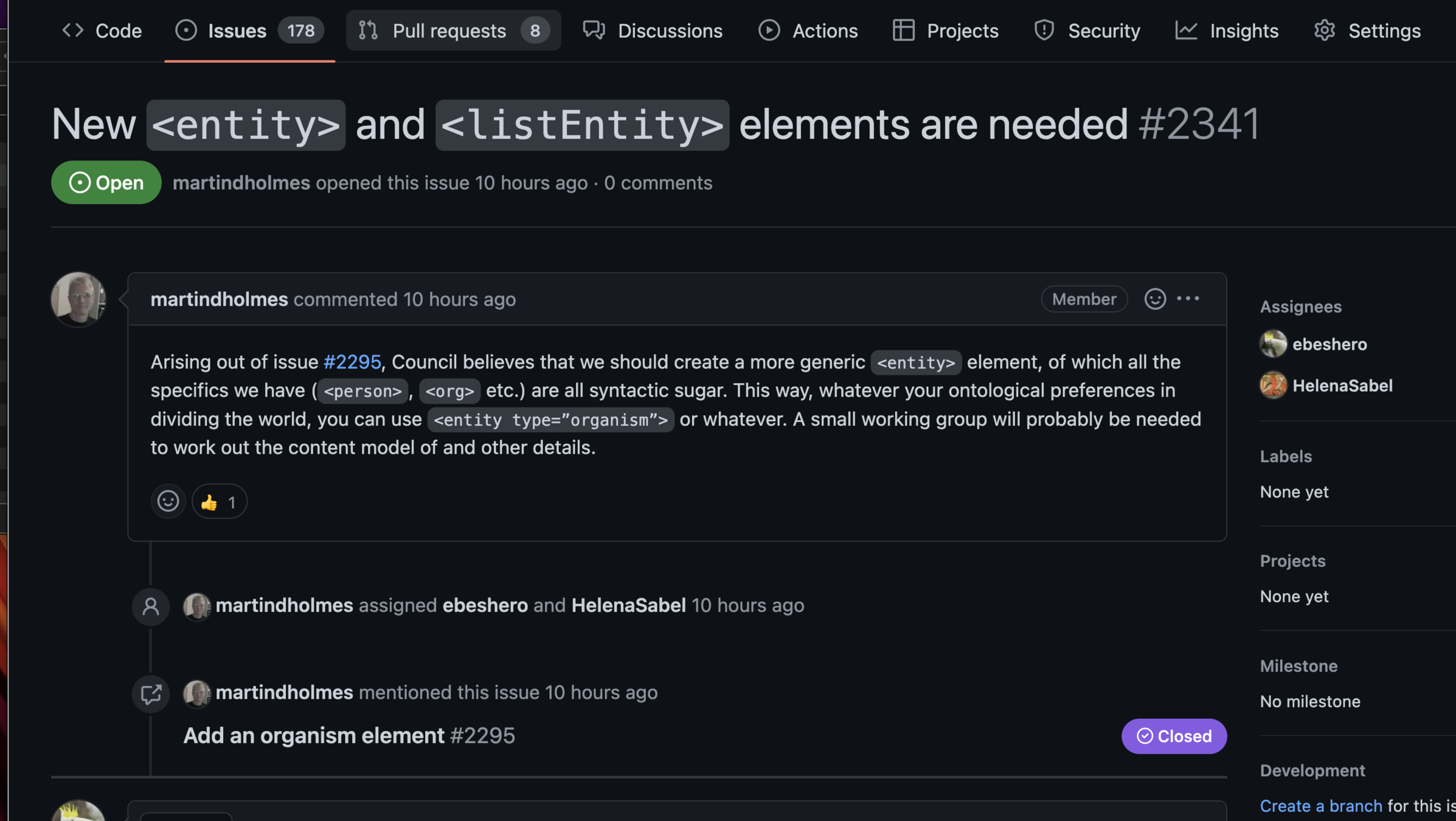
What can we do with the new gender and sex encoding?
Examples / discussion
Chap. 1
He--for there could be no doubt of his sex [. . .]
Chap. 3
He stretched himself. He rose. He stood upright in complete nakedness before us, and while the trumpets pealed Truth! Truth! Truth! we have no choice left but confess--he was a woman. [. . .] We may take advantage of this pause in the narrative to make certain statements. Orlando had become a woman--there is no denying it. But in every other respect, Orlando remained precisely as he had been. The change of sex, though it altered their future, did nothing whatever to alter their identity. Their faces remained, as their portraits prove, practically the same. His memory--but in future we must, for convention's sake, say 'her' for 'his,' and 'she' for 'he'--her memory then, [. . .]
from Orlando: A Biography by Virginia Woolf (1928)
The change seemed to have been accomplished painlessly and completely and in such a way that Orlando herself showed no surprise at it. Many people, taking this into account, and holding that such a change of sex is against nature, have been at great pains to prove (1) that Orlando had always been a woman, (2) that Orlando is at this moment a man. Let biologists and psychologists determine. It is enough for us to state the simple fact; Orlando was a man till the age of thirty; when he became a woman and has remained so ever since.
more from Ch. 3
from Orlando: A Biography by Virginia Woolf (1928)
<person>
<persName>Orlando</persName>
<sex from="#ch1" to="#ch3" value="M"/>
<sex from="#ch3" value="F"/>
<gender value="fluid"/>
</person>
<person>
<persName>Orlando</persName>
<sex from="#ch1" to="#ch3" value="M"/>
<sex from="#ch3" value="F"/>
<gender value="W"/>
</person>
<person>
<persName>Orlando</persName>
<sex from="#ch1" to="#ch3" value="M"/>
<sex from="#ch3" value="F"/>
<gender from="#ch1" to="#ch3" value="M"/>
<gender from="#ch1" to="#ch3b" value="NB"/>
<gender from="#ch3b" value="W"/>
<persPronouns>he/they/she</persPronouns>
</person>